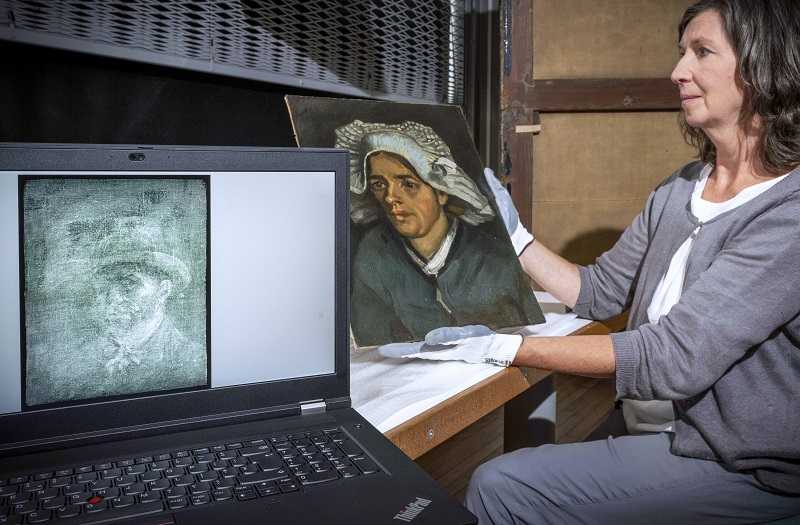
An X-ray image of a Vincent Van Gogh self-portrait; Van Gogh’s “Head of a Peasant Woman,” 1885.
16:40 JST, July 15, 2022
Frances Fowle, the senior curator at the National Galleries of Scotland, got what was likely to be the most exciting text message of her career while waiting in line at a fish shop on a Friday afternoon. It was an image from an X-ray. Not of broken bones – but of a previously unknown self-portrait by Vincent Van Gogh.
“Look what I’ve discovered,” wrote her colleague Lesley Stevenson.
Stevenson, a conservator at the Scottish National Gallery of Modern Art, found the painting when she X-rayed another piece by Van Gogh, “Head of a Peasant Woman,” ahead of an exhibition – a routine step that normally does not reveal such a major find.
Hidden under layers of glue and cardboard was another painting on its reverse – a portrait of a man in a hat with a scarf tied around his throat.
“I saw it then and there: It was a self-portrait by Van Gogh, on the back of our painting,” Fowle said.
The Van Gogh Museum in Amsterdam has examined the X-ray of the newly uncovered painting, which is “almost certainly” a Van Gogh self-portrait, the National Galleries of Scotland said in a news release. Still, experts are searching for ways to uncover it without damaging the painting under whose canvas it sits so they can confirm its authenticity.

Peasant Woman” and an X-ray image of the hidden self-portrait
Van Gogh was known to reuse canvasses because of lack of money, and Scottish conservators believe that was the case here. Several other self-portraits from the Nuenen period – between 1883 and 1885, when Van Gogh lived in the southern Dutch town – have been discovered on the backs of his paintings and now hang in museums in the Netherlands and the United States.
Conservators suspect that, at some point, the self-portrait was covered up to make room for “Head of a Peasant Woman,” an 1885 study for a larger painting, “The Potato Eaters,” widely considered one of Van Gogh’s masterpieces. It had been hiding in plain sight, inside a painting that had belonged to the National Galleries of Scotland for over 60 years.
Conservators who were preparing for the exhibition on impressionist art at the Royal Scottish Academy in Edinburgh said they didn’t expect anything much from the X-ray.
“This is a routine type of investigation that conservators have been using for quite some time,” Stevenson said in an interview released by the National Galleries to promote the exhibition – and the possible new Van Gogh self-portrait. “It gives us information about how the composition evolved, whether or not there were any changes. And lo and behold, we were quite surprised to discover a completely different painting in the X-ray image.”
Experts think the self-portrait was covered up with cardboard around 1905, “when the Peasant Woman was lent to an exhibition at the Stedelijk Museum, Amsterdam,” according to a news release. “At this date the Peasant Woman was evidently considered more ‘finished’ than the Van Gogh self-portrait,” it added.
“Head of a Peasant Woman” changed hands several times in the years following, until it was acquired by private collectors in Scotland and given to the National Galleries in 1960.
“Knowing that [the newly uncovered self-portrait is] there – in a painting that’s in the National Galleries of Scotland, in a collection that belongs to the people of Scotland – is incredibly important and significant,” Stevenson said. “Hopefully, it will encourage people to come and have a look.”
The National Galleries of Scotland already own three works by Van Gogh, painted between 1885 and 1889 – “and then suddenly, we have potentially another, which is probably the most exciting one of all,” Fowle said in the series of interviews released Thursday by the public art body.
This kind of “major” discovery “happens once, twice in a conservator’s lifetime,” Stevenson said.
This particular find was “extra special,” she said, because she believes it is a self-portrait, and “those images of the artist by the artist have a special quality – they’re very enigmatic. They’re giving us an insight into how [the artist is] thinking of themselves.”
The announcement of the find early Thursday generated interest from social media users, who joked that they would check the backs of paintings in their homes, just in case they contained a stray masterpiece or two.
But they may be disappointed: According to the Guardian, in a typical year, the Van Gogh Museum in Amsterdam “gets up to 300 inquiries from people believing they own a lost Van Gogh. Very few of those make it to the museum, and even fewer are found to be the real deal.”
"News Services" POPULAR ARTICLE
-

American Playwright Jeremy O. Harris Arrested in Japan on Alleged Drug Smuggling
-

Japan’s Nikkei Stock Average as JGB Yields, Yen Rise on Rate-Hike Bets
-

Japan’s Nikkei Stock Average Licks Wounds after Selloff Sparked by BOJ Hike Bets (UPDATE 1)
-

Japanese Bond Yields Zoom, Stocks Slide as Rate Hike Looms
-

Japan’s Nikkei Stock Average Buoyed by Stable Yen; SoftBank’s Slide Caps Gains (UPDATE 1)
JN ACCESS RANKING
-

Keidanren Chairman Yoshinobu Tsutsui Visits Kashiwazaki-Kariwa Nuclear Power Plant; Inspects New Emergency Safety System
-

Imports of Rare Earths from China Facing Delays, May Be Caused by Deterioration of Japan-China Relations
-

University of Tokyo Professor Discusses Japanese Economic Security in Interview Ahead of Forum
-

Japan Pulls out of Vietnam Nuclear Project, Complicating Hanoi’s Power Plans
-

Govt Aims to Expand NISA Program Lineup, Abolish Age Restriction



















